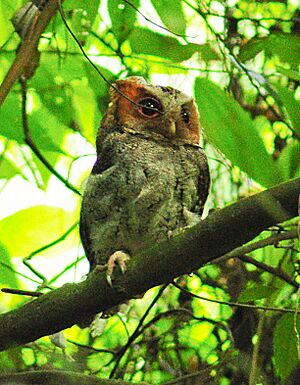Negros scops owl facts for kids
Quick facts for kids Negros scops owl |
|
|---|---|
 |
|
| Conservation status | |
| Scientific classification | |
| Genus: |
Otus
|
| Species: |
nigrorum
|
The Negros scops owl (Otus nigrorum), also called the Visayan scops owl, is a small type of owl. It lives only on the islands of Negros and Panay in the Philippines. This owl belongs to the family of typical owls, called Strigidae. It used to be thought of as a subspecies of the Philippine scops owl. Sadly, this special bird is in danger because its home is disappearing, and some people hunt it to sell as a pet.
What Does It Look Like?
The Negros scops owl is a fairly small owl. It lives in forests in lowlands and foothills on Negros and Panay islands. It's the only scops owl found there.
This owl has dark brown feathers on its back. Its belly is a pale gray color. Its face is a reddish-brown, with a black line around it. There's also a light gray V-shape between its eyes.
Sometimes, it might be confused with the Luzon boobook. But the Negros scops owl has orange eyes, not yellow. Also, its chest doesn't have brown streaks like the boobook's. When it sings, it makes a series of yelps that go down in pitch.
This owl is the smallest and lightest-colored among the owls in the Philippine scops owl group.
What Do They Eat and How Do They Live?
Negros scops owls are hunters at night. They mostly eat insects. These owls usually live alone or in pairs that stay together.
They can have babies throughout the year. A mother owl usually lays one or two eggs at a time. They build their nests inside tree hollows. You can find their nests in the forests of the Philippine lowlands.
Where Do They Live and Are They Safe?
The natural habitats for the Negros scops owl are warm, wet forests. These include both lowland and mountain forests. They prefer old-growth forests, which are very old and untouched. They can also live in younger forests that have grown back. However, they are healthiest and most numerous in the old-growth forests. They live in forests up to 1,000 meters (about 3,300 feet) above sea level.
The IUCN Red List says this bird is a vulnerable species. This means it's at high risk of becoming endangered. Experts believe there are only about 1,000 to 2,499 adult owls left.
The biggest danger to these owls is that their forest homes are being destroyed. This happens because of both legal and illegal logging. Forests are also cleared to make farms using a method called slash-and-burn. People also cut down trees for charcoal and for mining.
There has been a lot of forest loss on both Negros and Panay islands. By 2007, only about 3% of the forests on Negros and 6% on Panay were left. Much of this remaining forest is in higher mountains, where these owls don't live as well. Sadly, these small forest areas are still shrinking because of the threats mentioned.
Right now, there aren't any specific plans just for saving the Negros scops owl. However, they do live in a few protected areas. These include Northern Negros Natural Park, Mount Kanlaon National Park, and Northwest Panay Peninsula Natural Park. But even in these protected places in the Philippines, it's hard to stop hunting and illegal logging completely.


